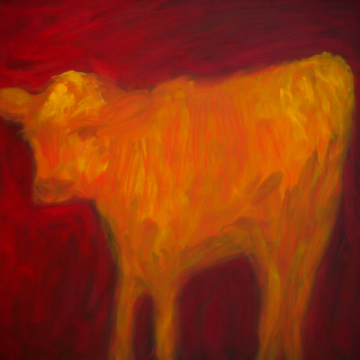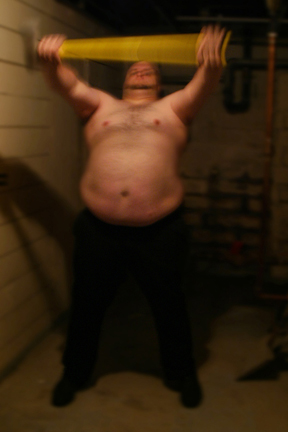A Neighborhood Visit: “Spring Cleaning” at Niche
Alex Starace attends the Spring Cleaning Show at the Niche 3708 Gallery and discovers the work of some refreshingly talented and intelligent artists.


Visiting Jared Fuller’s Niche 3708 Gallery is a lot like visiting someone’s living room. There are rugs on the floor, a coffee table with complementary water, a piano in one corner, and a friendly man working behind a desk in another corner. Music is playing and the gallery, though small (about the size of, well, a living room), is very inviting. It’s a proving ground for young or unknown artists – a small, intimate gallery tucked away in a residential neighborhood, one of several such galleries scattered throughout the city. What distinguishes Niche 3708 is how professional and polished the gallery feels: everything is neat and organized, there’s no unused open space, no areas of the gallery “to be installed,” no available glimpses of the back rooms. The interior decorating has a consistent, seamless aesthetic of highbrow domesticity, one that, in and of itself, justifies a visit. Furthermore, Fuller is polite and clearly has a talent for running the place.
The art on display in the current “Spring Cleaning Show” matches Fuller’s talent: while none of it is absolutely spectacular, every artist has a spark – each makes a contribution to the show and each has the potential to become a highly recognized artist. For example, Kari Maxwell’s painting, Another Side of Patience, is a close-up portrait of a cow. The cow is painted red on a white background and the title, if you’ve ever stood in a field and watched a cow drool into the wind, is absolutely hilarious. Equally apt with his titles is photographer Benny Moreno. All three of his pieces feature fat, thirty-ish men who look like they’re hard-partying fans of heavy rock. Moreno’s technique of blurry, dark-toned double exposures taken at night are a perfect visual match for these men’s lifestyle. Two of the pieces’ titles, Groundskeeper and Softball Coach, succinctly capture the men’s social roles – a stark and stunning contrast to the wild, excessive lives the men seem to lead. It’s as if the titles are the only thing reining the subjects in, as if these men who lead a late-night lifestyle (with all its concomitant glory) are still best defined by mundane daytime roles – a thought both depressing and realistic.
The work of Cassandra Monson provides a sharp contrast to that of Moreno: her drawings look like schematic outlines of inner ears. All of them are done on paper with different coloration and material (charcoal, acrylic, crayon, colored pencil, etc) and sometimes she’s a bit too clever for her own good. The drawings are often too nuanced, with too many colors, or too many rings of outline and highlight. However, the actual inner-ear-like shapes are compelling in their simplicity and strangeness, and Monson captures this quite well in her consumable art: she makes (and has for sale) buttons and stickers.
Each consumable is only two colors, one for the background, and one for the shape – the shapes stand alone and form symbols compelling not just for their primal curves and inscrutable starkness, but also because, as consumables, it seems they should be related to some company, or some cause, or some event: traditionally, stickers and buttons are easily and readily interpreted. Yet Monson’s stickers and buttons are decidedly not. Who, after all, wears a button for the only reason that: “Well, it looks nice. It’s a really neat shape, isn’t it? I have no idea what it means… it’s just a button.” Or who puts a sticker on the back of their car just because it’s “cool-looking”? The originality of the concept is rather breathtaking: it’s such a basic, simple idea, and yet no one seems to have done it before.
Such a willingness to slightly deviate from the norm is what defines the work in the “Spring Cleaning Show.” Take for example, Broken, by Jeannie Williams. It’s a mostly abstract painting with an image of a broken heart on the left side and dark overlapping, Franz-Kline-like brush strokes on the right side. The piece, despite its clear cliche, is visually appealing – by itself, it would stand alone as a legitimate piece of art. However, Williams has framed Broken quite innovatively: there’s a thin, outer, black frame and within it is a four-inch-wide inner frame made of glass – completely transparent. It is as though we are looking through a window at the painting of the heart – again, a cliche: “A window to your heart” – and yet the slightly unorthodox method of creating the cliche makes it enjoyable – less cliche-like because Williams has used a new method to tell us the old saw.
As the “Spring Cleaning Show” shows, little things like these make a big difference – the difference between boring, barely-worth-the-name art and pieces that are a bit edgy, that are, if nothing else, entertaining to view. And this is what’s best about the exhibition and the Niche 3708 Gallery in general: it’s exciting, the artists pay attention to detail and have moxie, and the people who run it (and who are shown there) are talented. Niche 3708 is one of those small galleries where you really might find the next Alec Soth or Kara Walker, where you just might catch new things before they become big. So it’s worth keeping an eye on.